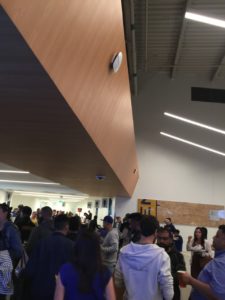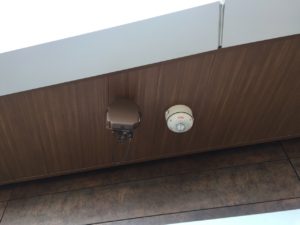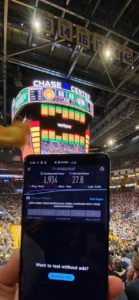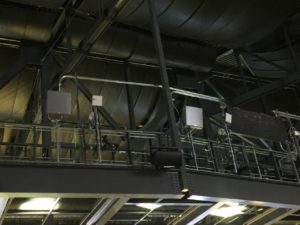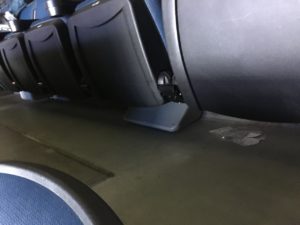
An under-seat Wi-Fi AP enclosure at Chase Center, foreground, with a DAS enclosure visible to the left. Credit all photos (except where otherwise noted): Paul Kapustka, MSR (click on any picture for a larger image)
Inside the shiny new home of the NBA’s Golden State Warriors, which sits on the edge of the San Francisco Bay, is a cellular DAS deployment from Verizon using Corning gear that may be the new forward-thinking model for cellular infrastructure for large public venues like stadiums and arenas. The 18,000-seat arena also has a Wi-Fi network using gear from Aruba, a Hewlett Packard Enterprise company, which supports the emerging Wi-Fi 6 standard for communications inside the main seating bowl.
But if you’re attending a Warriors game, or one of the many concerts scheduled at Chase Center, you may not ever see the equipment that brings the world-class connectivity to the fans. Both the DAS and the Wi-Fi networks utilize an under-seat antenna deployment method, just part of an aesthetic plan that does its best to minimize the visual impact of antennas and other wireless gear. Even deeper into the building is all the optical fiber supporting the networks, with capacity for future needs already in place.
During a mid-October 2019 visit before all the networks were fully tuned, Mobile Sports Report still got strong test results from both Wi-Fi and DAS networks in most areas in and around the arena, clear confirmation that the Warriors’ goal of having excellent wireless connectivity at their new home was right on track. And with the Corning ONE system in behind a DAS design built from the ground up with future needs in mind, as well as the expected capacity gains coming from Wi-Fi 6, the Warriors and their partners are confident they’ve built a wireless system worthy of their world-class venue goals.
“We feel extremely proud” of the venue’s wireless systems, said Brian Fulmer, director of information technology for the Golden State Warriors. Though the inevitable construction delays led to some late nights heading up to the arena’s Sept. 6, 2019 public debut, according to Fulmer all wireless systems were fully online for the opening Metallica concert, where the arena saw 2.58 terabytes of data used on the Wi-Fi network with another 2.69 TB used at another Metallica show a couple days later.
“It was a race to the finish line but we did it, and the performance speaks for itself,” said Fulmer.
Searching for ‘Best in Breed’
Editor’s note: This profile is from our latest STADIUM TECH REPORT, which is available to read instantly online or as a free PDF download! Inside the issue are profiles of the new Wi-Fi deployment at the University of Oklahoma, as well as profiles of wireless deployments at Fiserv Forum and the University of Florida! Start reading the issue now online or download a free copy!
If there was ever a chance to build the best-ever new arena, Chase Center was probably a once-in-a-lifetime opportunity. When you combine the championship run of the team on the court with a devoted fan base centered in one of the hottest economic markets ever, you have the liberty to search for quality instead of bargains on every level.
(Case in point: The Warriors were able to sell out of their new court-level luxury suites, which have rooms just under the stands that include private wine lockers and can cost up to $2 million per year. Clearly, this is a model that may not work in places that aren’t Silicon Valley.)For the privately financed $1.4 billion building, the Warriors turned to consulting firm Accenture to help determine the “best in breed” technology partners, especially on the wireless front. Several Warriors executives interviewed for this story did all agree on one main point: The team was not trying to install any technology to win imaginary awards for being the best or fastest building out there. Instead, it was all about how technology, especially wireless, could help bring about a world-class experience during every visit.
“Nobody shows up [at an arena] just looking for fast wireless speeds,” said Mike Kitts, the Warriors’ senior vice president for partnerships. “They want to interact. We wanted to create unforgettable experiences in an engaging environment. With the end in mind of a world-class experience, we knew great technology would absolutely play a role.”
Like a team drafting top players, the Warriors ended up choosing Verizon to lead the distributed antenna system (DAS) for cellular wireless, and Aruba for Wi-Fi. To build its neutral-host system, Verizon chose Corning and the Corning ONE platform, with an installation led by Communication Technology Services (CTS).
“We certainly leveraged the expertise of Verizon, as well as AT&T (which is also on the DAS as a client),” said Fulmer. “They’ve done this countless times, and they have the lessons learned of painful experiences.”
Building a DAS that can handle growth
Anyone in the stadium business in Northern California doesn’t have to look too far or remember too long ago to recall one such example of the pain that the nonstop growth in cellular demand can cause. After the San Francisco 49ers’ brand-new home, Levi’s Stadium, opened in 2014, the also brand-new DAS had to be upgraded the very next season to ensure it had enough capacity for the upcoming Super Bowl 50. Verizon, which basically invented under-seat DAS antennas for that deployment, said it had a goal at Chase Center to build a DAS that didn’t need upgrading for at least a few years.
Terry Vance, senior manager for Verizon’s Pacific market network performance group, said “the plan from day 1 was to build a DAS with capacity for today and tomorrow. We needed to build this DAS so that for the next 3 to 4 years, we won’t have to touch it.”Verizon also had to build the DAS in a way that complied with the Warriors’ stringent requirements for clear sight lines, especially in the main bowl seating area. According to the Warriors’ Fulmer, the team “looked at handrail [enclosure] designs,” but rejected them in favor of an under-seat approach. Though more costly in both equipment and construction, the under-seat approach was Verizon’s favored method as well to get more density in the arena.
What Verizon ended up with was a design that currently uses 71 active sectors, with 42 of those in the seating bowl. According to Vance, all the sectors in the bowl area can basically be split into two parts if needed, for a total of 84 potential bowl sectors. Currently, Vance said there are 598 under-seat DAS antennas in use.
According to Vance the Corning ONE system’s extensive use of optical fiber makes it easier to add capacity to the system as needed.
“The fiber to the edge [in the Corning system] is especially useful as you go to 5G,” Vance said. Though it’s not part of the shared DAS system, Verizon also has full 5G bowl coverage at Chase Center, one of the first arena deployments in California. Verizon also is using a couple of MatSing ball antennas, mounted in the rafters to provide cellular coverage to the floor area for concerts and other non-basketball events.
Right now AT&T is the only other carrier on the DAS, with participation from T-Mobile and/or Sprint pending depending upon the outcome of those two companies’ potential merger.
Jessica Koch, sports and entertainment director of business development for Corning optical communications, gave praise to integrator CTS for its deployment know-how, which she said was “critical to the success of this project.” Corning, Koch said, knows that for fans in large venues like Chase Center, “reliable connectivity without restriction – all the time, at full speed, on any device, from anywhere – has become the expectation in our connected world.”For Warriors president and COO Rick Welts, the best wireless system is one fans don’t see or worry about, but just use without concern.
“The best thing is if the phone just works, and I don’t have to think about it,” said Welts, who led a stadium tour during MSR’s October visit.
Though Verizon said the system went through some necessary optimization during the hectic early events schedule at Chase Center, Verizon engineers in December were getting DAS speed tests in excess of 100 Mbps for both download links in most locations, according to Philip French, vice president of network engineering for Verizon. Download speeds for 5G connections, he said, are breaking the 1 Gbps mark.
“This DAS is unique since it was the first one we’ve built with 5G in mind from the ground up,” French said. “It’s a very robust design, and for us this is the design of the future.”
Leading the way with Wi-Fi 6
Like several other stadiums that were being finished this past summer, Chase Center was able to take advantage of the release of Wi-Fi equipment that supports the emerging Wi-Fi 6 standard. Though all the new capabilities won’t be fully realized until most end-user devices also support the new version of Wi-Fi, having support for the technology inside the arena was key for the Warriors’ plans.
“You can never really be ‘future proofed’ but we were extremely fortunate with the timing [of Wi-Fi 6 gear arriving],” said the Warriors’ Fulmer. “We were right in the sweet spot for an initial deployment.”
According to Aruba, Chase Center has approximately 250 Aruba 500 Series APs (which support Wi-Fi 6) deployed in the main seating bowl, mostly in under-seat enclosures. Overall, there are approximately 852 total APs used in the full Chase Center network, which includes coverage inside the building as well as in the connected outdoor plaza areas.During our October visit, MSR got Wi-Fi speedtests of 27.3 Mbps on the download side and 18.2 Mbps on the upload side while standing outside the east entry doors near the big mirror balls that are selfie central for fans visiting the new arena. Inside the doors, our speedtest in the lobby got a mark of 55.8 Mbps / 68.6 Mbps.
On one upper concourse area, near several concession stands outside portal 57, we got a speedtest of 10.5 Mbps / 11.2 Mbps. In the seats in upper section 220 just before tipoff we got a mark of 46.0 Mbps / 28.0 Mbps, and in a lower-bowl concourse area outside portal 9 we got a test mark of 53.7 Mbps / 71.5 Mbps.
According to Aruba, several events other than the Metallica concerts have passed the 2 TB Wi-Fi data mark so far, with several events seeing more than 8,000 unique clients connected and marks of 6,000+ concurrent connected devices and 2.6 Gbps of throughput.
The Warriors’ Fulmer praised not just the Wi-Fi gear but the full “end to end network solutions” available from Aruba as well as from parent Hewlett Packard Enterprise, which is a founding partner at Chase Center.
“We’re still only three months in, and there’s a lot more that we want to do,” Fulmer said. “It was not a small undertaking. But I think we can let the technology speak for itself.”
